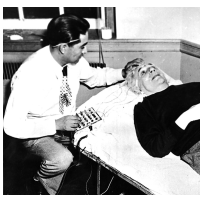Newly Discovered Photos of Einstein’s Brain Provide Insights
 Albert Einstein's brain studied by Dr. Alejandro Arellano in 1950 (AP Photo)
Albert Einstein's brain studied by Dr. Alejandro Arellano in 1950 (AP Photo)
Scientists still can’t say what exactly made Albert Einstein a genius, but newly published photos of his brain have provided some new insights.
Anthropologist Dean Falk of Florida State University and other experts recently examined a series of photographs taken of Einstein’s brain after he died in 1955. Their conclusion?
“Einstein's brain differs from the average human brain,” Falk told NPR. “In various parts, it’s more convoluted. It’s bumpier, and that may be related to an increase in the neurons.”
Einstein’s brain was only average in size. But several regions featured more convolutions and folds than normal. For instance, Einstein’s prefrontal cortex, which facilitates planning, focus and perseverance—was greatly expanded, compared to other brains.
The newly discovered photographs had been taken by pathologist Thomas Harvey during the hours immediately after Einstein’s death. Three years after Harvey’s own death in 2007, his estate donated Harvey’s work to the National Museum of Health and Medicine in Silver Spring, Md. Fourteen of Harvey’s photos of Einstein’s brain were analyzed by a team headed by Falk. The results, presented in this month’s issue of the journal Brain, shed new light on one of the world’s most studied and celebrated individual human organs.
-Noel Brinkerhoff, Danny Biederman
To Learn More:
Scientists Get a New Look At Einstein's Brain (by Helen Thompson, NPR)
Why Einstein Was A Genius (by Michael Balter, Science Magazine)
- Top Stories
- Unusual News
- Where is the Money Going?
- Controversies
- U.S. and the World
- Appointments and Resignations
- Latest News
- Trump Announces He Will Switch Support from Russia to Ukraine
- Americans are Unhappy with the Direction of the Country…What’s New?
- Can Biden Murder Trump and Get Away With it?
- Electoral Advice for the Democratic and Republican Parties
- U.S. Ambassador to Greece: Who is George Tsunis?






Comments